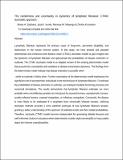The randomness and uncertainty in dynamics of lymphatic filariasis: CTMC stochastic approach

View/
Date
2024-02-15Author
Stephano, Mussa A.
Irunde, Jacob
Mayengo, Maranya
Metadata
Show full item recordAbstract
Lymphatic filariasis represents the primary cause of long-term, permanent disability, and dysfunction in the human immune system. In this study, we have devised and assessed deterministic and continuous-time Markov chain (CTMC) stochastic models to gain insights into the dynamics of lymphatic filariasis and approximate the probabilities of disease extinction or outbreak. The CTMC stochastic model is an adapted version of the existing deterministic model that accounts for uncertainties and variations in disease transmission dynamics. The findings from the deterministic model indicate that disease extinction is possible when , while an outbreak is likely when . Further examination of the deterministic model emphasizes the significant role of asymptomatic individuals in the transmission of lymphatic filariasis. To estimate the probabilities of disease extinction or outbreak, we employed multitype branching processes and numerical simulations. The results demonstrate that lymphatic filariasis outbreaks are more probable when microfilariae parasites are introduced by exposed humans, asymptomatic humans, acutely infected humans, exposed mosquitoes, or infectious mosquitoes. Conversely, the disease is more likely to be eradicated if it originates from chronically infected humans. Utilizing stochastic methods provides a more authentic portrayal of how lymphatic filariasis spreads, granting a better understanding of the spectrum of potential results and their related probabilities. Therefore, stochastic CTMC models become indispensable for generating reliable forecasts and well-informed choices in situations where deterministic models might oversimplify or inaccurately depict the inherent unpredictability.
URI
https://doi.org/10.1140/epjp/s13360-024-04945-2https://dspace.nm-aist.ac.tz/handle/20.500.12479/2664
